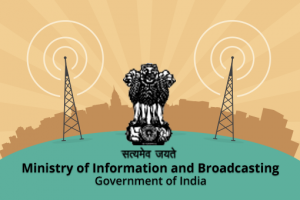I. Introduction:
On November 09, 2022, the Ministry of Information and Broadcasting (MIB)’s Broadcasting wing passed guideline for uplinking and downlinking of television channels (“Guidelines”) that extends to whole of India and has come in effect from November 09, 2022. The Guideline has replaced the previous two guidelines for uplinking and for downlinking, both dated December 05, 2011 as well as the guidelines of 2015.
In brief, uplink means transmission of the information from ground station to the satellite and downlink means transmission of the information from the satellite to one or more ground stations and/or receivers. The Guidelines are in respect of the process and permissions as well as guidelines to be followed while setting up and running a television channel.
II. Key Highlights:
a) Online applications on Broadcast Seva by companies/ LLPs for:
- setting up teleport (that is the earth station facility from where multiple TV channels carrying audio, video content can be uplinked to a geostationary satellite on permitted frequency band) / teleport hub (that is a set-up of teleports for uplinking of TV channels where multiple antennas are installed for different satellites).
- uplinking a news as well as non-news television channel from teleport(s) and satellite(s)
- downlinking a TV channel
In case the company/ LLP’s application is rejected, the same is to be communicated to such company/ LLP along with the reasons.
Such permission obtained via the applications shall be valid for 10 years. The companies can apply for renewal of ten years atleast three months prior to end of the month of their permission period provided that their net worth is as per the Guidelines at the time of renewals.
b. For News channel as well the applications are accepted online on Broadcast Seva, however, the permission is valid for 5 years and the same can be further renewed for five years. The Guidelines also provide for details for application and process in respect of purchase and hiring of Digital Satellite News Gathering (DSNG) and Satellite News Gathering (SNG) equipment.
c. The news channels that have obtained permission under the Guidelines may uplink content by using SNG/ DSNG equipment or by hiring such equipment from permitted entity. Such hiring is required to be registered with the Ministry on the Broadcast Seva. Hence, no separate permission is required to the news and current affairs channels to live telecast the content. Further, non-news and current affairs channels may uplink an event live in/from India by registering itself online on the Broadcast Seva and on payment of fees specified in the Guidelines at least 15 days before such first date of live event. Failure to do the same amounts to penal action viz. warning and/or stoppage of live broadcast and may also include prohibition of broadcast upto 10 (ten) days and debarment from live broadcast for a period upto six months.
Separate conditions have been provided for uplinking of live events by a foreign channel.
d. The name and logo displayed by the company/ LLP on their television channel is restricted to only the name and logo that has been approved by the Ministry and display of any other name/logo shall result in penal action, that is, an order directing removal of dual logo/unpermitted logo and Ministry may also prohibit broadcast for upto 30 days for non-compliance.
e. The change in language, mode of transmission, change in address and relevant particulars of company/LLP and change in the company/LLP viz. resignation of Director/ Designated Partner, etc. are to be merely intimated on the Broadcast Seva to the Ministry, and no prior permission is required for the same.
f. If a television channel that has received permission is not operational for a period of more than 60 (sixty) days, the company/ LLP is required to inform the same to the Ministry along with the reasons. Failure to do the same will result in penal action of warning being given to the company/ LLP. Further, a channel must not remain non-operative for a continuous period of more than 90 days.
g. As airwaves/ frequencies are public property, they are to be used in the best interest of the society, hence the permitted companies/ LLPs may undertake public service broadcasting for a minimum period of 30 minutes in a day on themes of national importance and of social relevance such as agriculture and rural development, health and family welfare, welfare of women and weaker sections of the society, etc.
III. Main advantages of the revised guidelines:
A. Ease of compliance:
- Easy online applications process.
- There is no requirement for seeking permission for live telecast of events, only prior registration of events to telecast live is necessary.
- There is no requirement of prior permission for change of language or conversation of mode of transmission from Standard Definition (SD) to High Definition (HD) or vice versa; only prior intimation required.
- In case of emergency, for a company/LLP with only two Directors/Partners, a Director/Partner can be changed, subject to security clearance post such appointment, to enable business decision making;
- A company/LLP can use news gathering equipment other than DSNG, such as optic fibre, Bag back, mobile, etc. for which no separate permission would be necessary.
B. Ease of doing business:
- Specific timelines have been proposed for grant for permission.
- Limited Liability Partnership (LLP) entities can also seek permission.
- LLPs/ companies would be allowed to uplink foreign channels from Indian teleports which would create employment opportunities and make India a teleport-hub for other countries.
- A news agency can get permission for a 5 year period as against one year at present.
- A channel can be uplinked by using facilities of more than one teleport/ satellite as against only one teleport/satellite at present.
- It has broadened the possibility of allowing transfer of TV Channel/Teleport to a company/ LLP as permissible under the Companies Act/ Limited Liability Act.
C. Simplification and Rationalization of the guidelines:
- One composite set of Guidelines has replaced two separate guidelines of 2011 for uplinking and downlinking respectively, both dated December 5, 2011. Further, the structure of the guidelines has been systematized to avoid duplication and common parameters.
- The penalty clauses have been rationalized and separate nature of penalties have been proposed for different type of contraventions as against uniform penalty at present. The penalties are covered under Part IX of the Guidelines.
E. Other Highlights:
- The companies/LLPs having permission to uplink and downlink a channel may undertake public service broadcasting (except where it may not be feasible) for a minimum period of 30 mins in a day on themes of national importance and of social relevance.
- The TV Channels uplinking in frequency band other than C band are mandatorily required to encrypt their signals.
- There are provisions in respect of Security Deposits included in the Guidelines to ensure payment of dues.
IV. Conclusion:
The new Guidelines has surfaced several welcoming changes in accordance with the ever-growing technology of the present times, especially in respect of the live broadcasts. Further, one simple guideline instead of separate guidelines for both uplinking and downlinking and uniformity in both along with the express mention of the timelines within which permissions shall be granted is definitely an essential change that will positively impact the effectiveness of application of the Guidelines. It will be interesting to see the observance of these Guidelines as well as its contribution in the prospective growth of the satellite broadcasting in the present times that shows bias towards the Over The Top (OTT) platforms.
Image source: here

















![BREAKING: GOVERNMENT PROPOSES TO AMEND THE COPYRIGHT RULES, 2013 SEEKS TO BRING ALL MODES OF BROADCAST WITHIN THE AMBIT OF STATUTORY LICENSING PROVISIONS [READ DRAFT RULES]](https://iprmentlaw.com/wp-content/uploads/2019/06/copyright-question-mark-100x70.png)